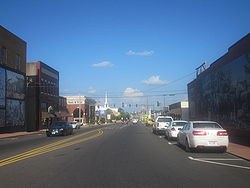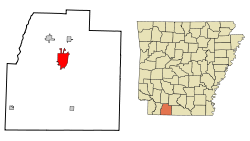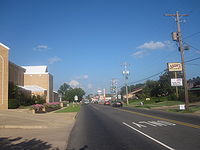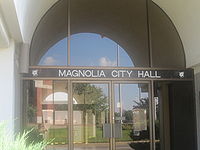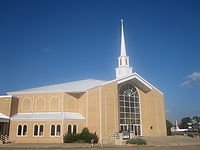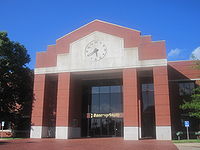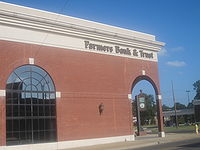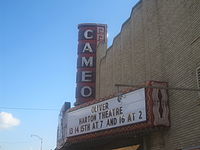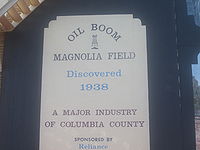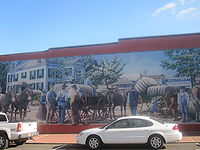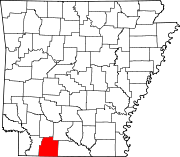- Magnolia, Arkansas
-
Magnolia, Arkansas — City — Downtown Magnolia Location in Columbia County and the state of Arkansas Coordinates: 33°16′27″N 93°14′1″W / 33.27417°N 93.23361°WCoordinates: 33°16′27″N 93°14′1″W / 33.27417°N 93.23361°W Country United States State Arkansas County Columbia Government – Type Council-Strong Mayor – Mayor Parnell Vann (elected 2010) Area – Total 9.3 sq mi (24.2 km2) – Land 12.94 sq mi (24.1 km2) – Water 0.0 sq mi (0.0 km2) Elevation 338 ft (103 m) Population (2010) – Total 11,577 – Density 1,167.5/sq mi (450.5/km2) Time zone Central (CST) (UTC-6) – Summer (DST) CDT (UTC-5) ZIP codes 71753-71754 Area code(s) 870 FIPS code 05-43460 GNIS feature ID 0077578 Magnolia is a city in Columbia County, Arkansas, United States, that was founded in 1853. At the time of its incorporation in 1858, the city had a population of about 1,950. The city grew slowly as an agricultural and regional cotton market until the discovery of oil just east of the city in March, 1938, with the Barnett #1 drilled by the Kerr-Lynn Company. The Magnolia Oil Field was an important discovery, not just for the city but for the nation, as it was the largest producing field (in volume) during the early years of World War II, helping to fuel the American war effort. According to 2006 Census Bureau estimates, the population of the city is 10,951 according to the U.S. Census Bureau reports of 2009. The city is the county seat of Columbia County[1]. It is also home to the World's Largest Charcoal Grill and the World Championship Steak Cookoff, part of the Magnolia Blossom Festival.
Contents
Geography
Magnolia is located at 33°16′27″N 93°14′1″W / 33.27417°N 93.23361°W (33.274052, -93.233477)[2].
Magnolia is located in southwest Arkansas with an average altitude of 336 ft (102 m) above sea level according to NOAA. The heart of Southwest Arkansas (Miller Co., Lafayette Co., Columbia Co., Nevada Co., Little River Co., Hempstead Co., Sevier Co., Pike Co., Clark Co., and Howard Co.) has a mix of dense forest, farm prairies, and low rolling hills.
According to the United States Census Bureau, the city has a total area of 9.3 square miles (24 km2), of which, 9.3 square miles (24 km2) of it is land and 0.11% is water.
Magnolia is located about 50 miles (80 km) east of Texarkana, about 225 miles (362 km) east of the Dallas-Ft.Worth metro area, about 135 miles (217 km) south of Little Rock and about 84 miles (135 km) north of Shreveport, Louisiana.
Government
The city operated under a city council form of government until 2003. Voters elected to convert the city to a strong-mayor form of government, making the mayor's position a full-time position with veto power. Lane Jean was elected mayor in 1996.[3][4][5] The city employs approximately 50 individuals in 7 different departments, including the Police Department, the Fire Department, and Parks and Recreation.
Climate
Average Temperature: 64°. Average Rainfall: 50.3 inches http://www.magnolia-ar.com. The winters are mild but can dip into the teens at night and have highs in the 30s and even some 20s but average out around 50. The Springs are warm and can be stormy with strong to severe storms average highs in the mid 70s. Summers are often hot and humid and dry but with occasional isolated afternoon storms, highs in the mid to upper 90s and even 100s. In the fall the temps cool from the 90s and 100s to 80s and 70s. Early fall temps are usually in the 80s but can reach 90s and at times has reached 100. Late fall temps fall to 70s and 60s. It is not uncommon to see snow and ice during the winter. It has been known to snow a few times as late as April and as early as November in Magnolia.
Demographics
As of the census[6] of 2000, there were 10,858 people, 4,204 households, and 2,577 families residing in the city. The population density was 1,165.3 people per square mile (449.8/km²). There were 4,821 housing units at an average density of 517.4 per square mile (199.7/km²). The racial makeup of the city was 58.24% White, 39.38% Black or African American, 0.22% Native American, 0.65% Asian, 0.02% Pacific Islander, 0.48% from other races, and 1.00% from two or more races. Hispanic or Latino of any race were 1.07% of the population.
There were 4,204 households out of which 28.6% had children under the age of 18 living with them, 40.2% were married couples living together, 17.9% had a female householder with no husband present, and 38.7% were non-families. Of 4,204 households, 101 are unmarried partner households: 91 heterosexual, 4 same-sex male, 6 same-sex female households. 34.6% of all households were made up of individuals and 16.6% had someone living alone who was 65 years of age or older. The average household size was 2.33 and the average family size was 3.01.
In the city the population was spread out with 24.2% under the age of 18, 16.8% from 18 to 24, 23.1% from 25 to 44, 18.4% from 45 to 64, and 17.5% who were 65 years of age or older. The median age was 33 years. For every 100 females there were 84.8 males. For every 100 females age 18 and over, there were 79.4 males.
The median income for a household in the city was $29,897,as of 2005, and the median income for a family was $35,269. Males had a median income of $31,577 versus $20,840 for females. The per capita income for the city was $15,403. About 15.2% of families and 23.0% of the population were below the poverty line, including 32.9% of those under age 18 and 17.7% of those age 65 or over.
Economy
Magnolia when it was founded was a cotton, farm production, and marketing town. Slowly the town grew and in 1909 the Third District Agricultural School, subsequently known as Magnolia A&M and Southern State College, now known as Southern Arkansas University, was founded. During World War II Magnolia became a heavy manufacturing city. In 1938 oil and natural gas was discovered near the city in what was called the Magnolia Oil Field; the largest producing field by volume in the nation during the war. The city soon became a producer in steel, lumber, aluminum, bromine, rubber coated products and fuel cells for the military.
Magnolia is also the home corporate office of Amfuel, which is the largest designer and fabricator of composite material products for aviation, aerospace, military ground forces, and commercial transport industries.
The town's primary economic focus is heavy industrial, including Albemarle Corporation's Bromine Products Division (which has two facilities near town), Amfuel (which produces fuel cells for the military), and Sapa's extruded aluminum products facility. Also located in the area are several oil and brine drilling companies, many of which are locally owned, and timber companies, such as Deltic and Weyerhaeuser.
Major Industrial Employers: SAPA (750), Albemarle (739), Amfuel (380), CMC (344), Weyerhaeuser (250), Deltic Timber (125), Partee Flooring (95), and Southern Aluminum (90).
LARGEST EMPLOYERS/NON-MANUFACTURING
Magnolia Public School System, Education, 346 Southern Arkansas University, Higher Education, 304 Magnolia Hospital, Health Services, 253 Columbia County County, Government, 110The unemployment rate in Magnolia, AR, is 9.40%, with job growth of -0.40%. Future job growth over the next ten years is predicted to be 29.70%, according to Sterling's www.bestplaces.net/city/Magnolia-Arkansas.aspx. The U.S. unemployment rate average for the month of June is 9.2%, Arkansas' average is 7.2%.
Festivals
Magnolia is also home to the Magnolia Blossom Festival and World Championship Steak Cookoff. The festival has been featured on the Food Network and attracts 40,000+ to the event.
Festival of Lights-Late November through Late December.
Magnolia is also known locally for its downtown shopping on the square and its natural beauty. One contributing factor to its beauty are the downtown murals, one of which was signed by Charlton Heston.
Education
Magnolia High School is known for its boys' basketball teams winning 7 State Championships, 1 Overall State Championship (which is no longer played in Arkansas), and 19 conference titles. The most recent State Championship was in 1997 and the most recent appearance was in 2006. The recent conference titles were in 1999, 2006, and 2007. The Magnolia Panthers compete in [Arkansas Activities Association|Arkansas Activities Association's] 5A-Southwest conference. Magnolia is also frequently the lead school in test scores in southwest Arkansas.[citation needed] Since 1999 Magnolia High School gradutates have received well over $1 million in scholarship money each year, with the class of 2008 being first to reach $2 million in scholarship offers.
Magnolia has two school systems: Magnolia Public Schools (public), and Columbia Christian School(Private).
Graduation Rates- High school or higher: 75.4%, Bachelor's degree or higher: 24.1%, Graduate or professional degree: 7.0%.[7]
Magnolia is the home of Southern Arkansas University, a public university that offers four-year and advanced (Master's level) degrees in business, public administration, computer information systems, education, counseling, education administration, and criminal justice. With a student body of over 3,100, its most notable programs are agriculture, business, and education. The university's cultural focus is Harton Theatre, which provides a venue for both departmental plays, concerts, and local cultural events.
Notable persons from Magnolia
- Harvey C. Couch, utility and railroad entrepreneur
- Billy Joe Daugherty (1952–2009) - minister & Protestant pastor
- Andrew R. Johnson (1856–1933), Louisiana state senator from 1916–1924 and mayor of Homer taught school near Magnolia in the 1890s.
- Sidney Sanders McMath, Governor of Arkansas
- Carl Wafer, former American football defensive end who played for the New York Giants and Green Bay Packers in 1974.
- Roy Green, former American football wide receiver in the National Football League who played for the St. Louis Cardinals (1979–1987), Phoenix Cardinals (1988–1990) and Philadelphia Eagles (1991–1992).
- Charlaine Harris, author of the Sookie Stackhouse novels
- Robert Polk, former Army member, great person
Annexation
On January 12, 2007, Magnolia annexed 2,325 acres (9.41 km2) east of the city, which includes approximately 1,100 people, increasing the population to 11,578. The city is expected to receive between $60,000-$70,000 in state turnbacks per year as a result. Population: 11,766 as of June 2007 according to the City of Magnolia (http://www.magnolia-ar.com).
Transportation
Magnolia Municipal Airport is a city-owned, public-use airport located three nautical miles (6 km) southeast of the central business district of Magnolia.[8]
References
- ^ "Find a County". National Association of Counties. http://www.naco.org/Counties/Pages/FindACounty.aspx. Retrieved 2011-06-07.
- ^ "US Gazetteer files: 2010, 2000, and 1990". United States Census Bureau. 2011-02-12. http://www.census.gov/geo/www/gazetteer/gazette.html. Retrieved 2011-04-23.
- ^ Texarkana Gazette. Oct. 27, 2009. Retrieved Dec. 23, 2010. http://www.texarkanagazette.com/news/localnews/2009/10/27/magnolia-mayor-running-for-state-represe-73.php
- ^ Lane Jean For State Representative. Retrieved Dec. 23, 2010. http://lanejeanforstaterepresentative.com/node/1
- ^ Magnolia, Ark., Elected Officials. Retrieved Dec. 23, 2010. http://www.magnolia-ar.com/elected/default.php
- ^ "American FactFinder". United States Census Bureau. http://factfinder.census.gov. Retrieved 2008-01-31.
- ^ http://www.city-data.com/city/Magnolia-Arkansas.html
- ^ FAA Airport Master Record for AGO (Form 5010 PDF). Federal Aviation Administration. Effective 11 February 2010.
External links
Municipalities and communities of Columbia County, Arkansas Cities Town Unincorporated
communitiesAtlanta | Jefferson
Categories:- Cities in Arkansas
- Populated places in Columbia County, Arkansas
- Micropolitan areas of Arkansas
- County seats in Arkansas
- Populated places established in 1853
Wikimedia Foundation. 2010.

